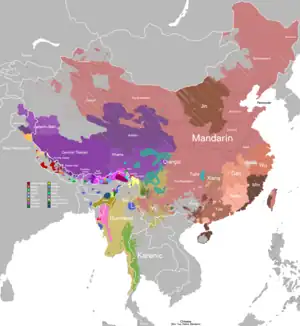Greater Siangic languages
Greater Siangic is a language grouping that includes the Siangic languages, Digaro languages (Idu Mishmi and Taraon) and Pre-Tani, the hypothetical substrate language branch of Tani before it became relexified by Sino-Tibetan. The Greater Siangic grouping was proposed by Roger Blench (2014), based on exclusively shared lexical items that had been noted by Modi (2013).[1] Blench (2014) argues that Greater Siangic is an independent language family that has undergone areal influences from Sino-Tibetan languages, and is not a branch of the Sino-Tibetan language family itself.
| Greater Siangic | |
|---|---|
| (proposed) | |
| Geographic distribution | Arunachal Pradesh |
| Linguistic classification | Sino-Tibetan? or an independent family |
| Subdivisions | |
| Glottolog | macr1268 mish1241 |
Various lexical items exclusively shared by Milang, Koro, Taraon, and Idu have also been noted by Modi (2013).[1] Modi (2013) suggests that Taraon could be closer to Milang than Idu is.
Languages
Blench (2014) lists the following languages in Greater Siangic.
- Greater Siangic
Sound correspondences
Modi (2013: 20-22)[1] notes the following sound correspondences among Milang, Taraon, Idu, and Proto-Tani.
| Milang | Taraon | Idu | Proto-Tani |
|---|---|---|---|
| -u | -a | -a | *-o |
| h- | s- | ||
| C- | Cl- | Cr- | |
| c- | t- | t- |
See also
- Greater Siangic comparative vocabulary list (Wiktionary)
References
- Modi, Yankee. 2013. The nearest relatives of the Tani group. Paper presented at the 19th Himalayan Languages Symposium, Canberra, Australia.
- Blench, Roger (2014). Fallen leaves blow away: a neo-Hammarstromian approach to Sino-Tibetan classification. Presentation given at the University of New England, Armidale, 6 September 2014.
- Post, Mark W. and Roger Blench (2011). "Siangic: A new language phylum in North East India", 6th International Conference of the North East India Linguistics Society, Tezpur University, Assam, India, Jan 31 – Feb 2.
